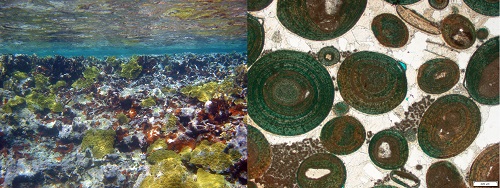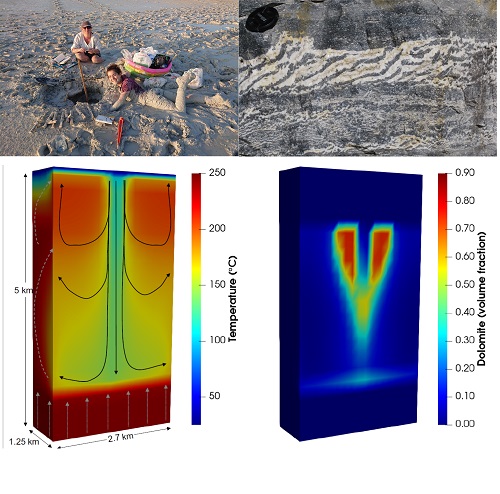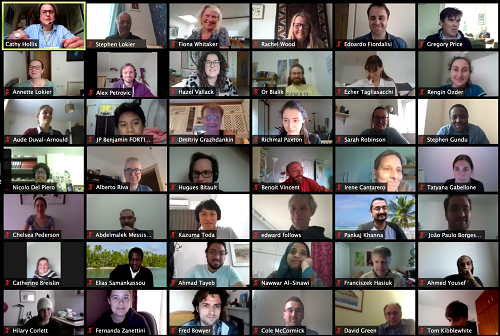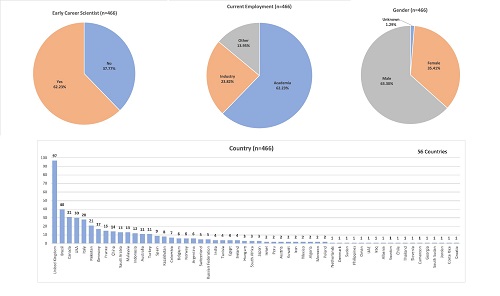Now is the time to rethink our approach to international conferences, say Cathy Hollis, Stephen Lokier and colleagues
Hollis, C. & Lokier, S., Brave New World. Geoscientist 30 (7), 10-15, 2020
https://doi.org/doi: 10.1144/geosci2020-098, Download the pdf here
The catastrophic COVID-19 global pandemic has forced us all to re-evaluate our lifestyles and adapt our working patterns. We have put many aspects of our lives on hold, and rescheduled events to some future date when a ‘new normal’ will be established. Many of us have turned to video conferencing to help us remain connected with colleagues, friends and family.
So, what of conferences?
Vital gatherings
 Figure 1 (left): Modern, shallow water carbonates (left) and calcite cemented oolitic grainstone (right). Images courtesy of Stephen Lokier
Figure 1 (left): Modern, shallow water carbonates (left) and calcite cemented oolitic grainstone (right). Images courtesy of Stephen Lokier
Conferences have long provided fora at which scientists and others gather, share results, discuss scientific advances and build working relationships. These gatherings are central and vital to the working model of academic life and remain an important component of continuing professional development in industry. Some of these meetings are an annual fixed point in our professional calendars, providing a touchstone for research and project planning.
Conferences are a trillion-dollar industry; annual conventions, such as those of the AGU, EAGE and AAPG attract many thousands of delegates to see tens of thousands of presentations and exhibits. Conference presentations are where we road-test our ideas prior to publication, and ‘spread the word’ about new concepts, models, and techniques. Such interaction facilitates timely publication by garnering feedback, raising awareness and opening pathways for deeper discussion. At a smaller scale, even specialised conferences can see over a hundred people brought together at a single destination. In the best cases, delegates leave conferences relaxed, inspired and enriched, having broadened their scientific outlook, met new people and learnt something new.
Unfortunately, attendance at these events can be very expensive. Registration fees are typically hundreds of pounds or more, and once travel, accommodation and subsistence are included, the cost of a single international meeting can easily exceed £1K. As distance and time constraints mean that many delegates have no option but to travel by air, the carbon footprint of conferences can also be significant. Most individuals thus face difficult choices about which conferences to attend, with many being limited to attending only one event a year. For those based in more remote or less affluent institutions, or who are resident in nations with travel restrictions, these combined factors may make international conference attendance practically impossible.
We are all hoping to meet again in 2021 at events that have been cancelled this year, but how can we stay in-touch scientifically in the meantime, and what is the future for scientific conferences? A recent initiative, aiming to rejuvenate participation in conferences for postgraduate and early career researchers in the field of carbonate sedimentology, was an opportunity to assess the benefits of virtual conferences and showed they have a significant future beyond the current global crisis.
The Carbonate Forum
 Figure two (right): Examples of interdisciplinary carbonate geoscience that was presented at the conference, including geobiology and geochemistry of modern sediments and pore waters (top left, Fiona Whitaker and Hazel Vallack, University of Bristol, photograph courtesy of Gordon Coy), structural diagenesis and geomechanical controls on zebra dolomite formation (top right, Cole McCormick, University of Manchester) and numerical modelling of fault-controlled diagenesis (bottom, Tan Benjakul, University of Bristol).
Figure two (right): Examples of interdisciplinary carbonate geoscience that was presented at the conference, including geobiology and geochemistry of modern sediments and pore waters (top left, Fiona Whitaker and Hazel Vallack, University of Bristol, photograph courtesy of Gordon Coy), structural diagenesis and geomechanical controls on zebra dolomite formation (top right, Cole McCormick, University of Manchester) and numerical modelling of fault-controlled diagenesis (bottom, Tan Benjakul, University of Bristol).
In autumn 2019, a group of academic carbonate sedimentologists began to discuss the limited opportunities for postgraduate and early career researchers to present their work to a like-minded audience. We recognised that carbonate sedimentology (Figure 1) has diversified as a discipline, embracing sedimentary, hydrogeological and chemical processes, geobiology, GIS systems, numerical modelling, rock physics, and much more. Many advances in fundamental problems within the discipline, such as dolomitization processes, reconstruction of past climates and prediction of sedimentary architecture, have been made by integration of these different skill-sets (Figure 2).
Nevertheless, there are few conferences where those working across this broad range of topics can come together to discuss and share our knowledge and ideas. In particular, no single forum has specifically given a voice to those scientists at the early stages of their career. These individuals are often at the forefront of scientific advances, are typically custodians of rich, high quality datasets, are embedded in the current literature and have ideas that can be tested.
Bluntly, we recognised that there is an increasing tendency for conference organisers to compete for attendance by preferentially giving a voice to those of us with many years of experience; a practise that is detrimental to the progression of the next generation of scientists and hence negatively impacts the broader scientific community.
To address this need, we invited abstracts for a two day Carbonate Forum scheduled at the University of Manchester on 12-13th May 2020 and garnered supported from the International Association of Sedimentologists, the British Sedimentological Research Group and the Society for Sedimentary Geology.
Maximising engagement
From the outset, the meeting was committed to featuring presentations from postgraduate researchers and early-career scientists (individuals with no more than seven years of experience or part-time equivalent since award of their PhD, excluding periods of parental/care leave) and to keeping attendance costs to an absolute minimum. To maximise engagement, we stipulated that talks would be short, with ample discussion time, and encouraged the presentation of fundamental science. We encouraged submission of work in progress and ideas that were not necessarily fully formed.
The response was excellent and we quickly filled all 32 oral presentation slots with submissions by early career scientists. In an important departure from normal conference practice, mentoring was provided to contributors, with each abstract reviewed by two members of the scientific committee. Feedback was given, and the lead author invited to resubmit a modified version for publication in the abstract volume.
When the UK entered ‘lockdown’ in late March, we had to quickly decide how to proceed. Although the schedule of conferences that had been postponed until 2021 was looking increasingly full, we also wanted to sustain the high level of enthusiasm for the meeting and provide some much needed ‘time out’ and social contact within the community. On this basis, we decided to keep the same 2020 time slot but move the meeting fully online - albeit with very little time left to prepare and no real idea of how such an event might work.
The Carbonate Forum online
 Figure 3 (left): Participants in the last session of the Carbonate Forum
Figure 3 (left): Participants in the last session of the Carbonate Forum
A solution to both conference registration and delivery was found through Seds Online (https://sedsonline.com) - a new initiative founded by Stephen Lokier (Bangor University), Catherine Russell (University of Leicester) and Joanna Pszonka (Mineral and Energy Economy Research Institute of the Polish Academy of Sciences). Established to provide an interactive, adaptable and accessible online platform for anyone with an interest in the field of sedimentology, Seds Online aims to support the community and make sedimentology meetings more accessible. It’s free to join and open to all, thanks to sponsorship from the International Association of Sedimentologists – through their website, Zoom Pro® licence and experience in running webinars, we were quickly able to derive a protocol for online conference registration, attendance and delivery (Figure 3).
We advertised the meeting via Seds Online and social media, and interest ramped up so rapidly that we ended up curtailing initial registration at 700. We added two keynote speakers, Prof Martin Blunt (Imperial College London) and Dr Ashleigh Hood (University of Melbourne) and created space for discussion within ‘breakout’ rooms. Posters were uploaded online, and presenters were able to introduce their poster during one of the sessions to attract interested delegates into their poster-dedicated breakout space. Support for the transition to online delivery was virtually unanimous, with only one speaker withdrawing their submission – the vacated slot was quickly filled.
We hoped that by adopting a format as similar as possible to that of a conventional, face-to-face meeting, we would create a familiar virtual meeting environment where participants felt comfortable, relaxed and focused on the science. Chaired themed sessions ran in 100 minute blocks with speakers given up to 12 minutes to present their research, followed by 8 minutes of discussion. If speakers overran, they were warned that their video (i.e. their presentation) would be turned off; happily, this proved redundant as all speakers ran perfectly to time. At the conclusion of each presentation, the chair invited audience questions to be submitted via the chat function in Zoom. The chair read out each question and the presenter responded.
Registration and security
To circumvent concerns about security, only people who had registered and collected their ‘meeting badge’ (i.e. responded to an email to pick up their personalised meeting link) were ‘admitted’ to the conference. All attendees were asked to honour the meeting code of not screen capturing any of the presented material. However, presenters were offered the opportunity to have their talks recorded and made openly available via the Seds Online website – an offer that was taken up by 80% of presenters.
To ensure sound and visual quality, all microphones and video feeds were turned off, apart from the speaker and session chair. All presenters were invited into a ‘Green Room’ prior to their session where they met the chair and did a quick microphone and video check to identify any problems prior to their presentation. In the rare cases where presenters had insufficient bandwidth, we turned off their video, and they just shared their screen and audio.
There are many potential risks associated with running an online meeting, particularly with such a short timeframe in which to prepare. Thankfully, all the things we anticipated might go wrong did not. There were no sound failures, and no significant interruptions or distractions from external noise, pets, children or Zoom-bombers. Maybe this was serendipitous, but the lack of hitches suggests that the freely available technology is very capable of running such events. From a security perspective, a few of the registrants did share their personalised meeting link, but these individuals were then denied entry to the meeting by a small volunteer tech team who monitored entry to the ‘waiting room’.
A greener, inclusive conference
All of the presenters ‘showed up’ and gave very high quality and thought provoking presentations that spanned the spectrum of carbonate geoscience. Any concerns about the degree of participation and interaction rapidly dissolved. In fact, the range, abundance and quality of questions far surpassed those at many conferences, with insightful, probing questions from postgraduate students through to highly experienced academics. Speakers were engaged, detailed and enthusiastic in their answers and often the hardest duty for session chairs was to keep the discussion within time. This suggests that the discomfort many people feel standing up and asking a question at a conference dissolves in a remote setting.
The original Carbonate Forum aimed for a maximum, and optimistic, 80 attendees, with most delegates expected to be from UK universities. In the end there were 466 participants over the two days, representing 56 countries, comprising early career researchers (62% of delegates), academics and industrial practitioners (Figure 4). Not surprisingly, the largest number of participants was from the UK (21%), but the numbers after that were surprising, with a significant contingent from North America (13%), Brazil (9%), Italy (5%) and Pakistan (5%). Many were participating in the conference late at night or very early in the morning. For those that could not watch all of the talks ‘live’, recordings provided the opportunity to catch up later.
As discussed above, attendance at international meetings can be challenging for a wide variety of financial, environmental, political or time-constraint reasons. However, it is a fair assumption that all of those who participated in the Carbonate Forum had a significant interest in the topics and, in an ideal world, would have wished to attend the physical meeting as originally envisioned.
Recognising this, we undertook a quick analysis of the hypothetical environmental impact of all of our international delegates flying to the UK to attend the meeting in person. Assuming travel from their nearest major airport, they would have flown a total of 4,298,500 km - a distance equivalent to 5.5 return trips to the moon (or 15.3 billion standard geological hammer lengths!) These flights would have generated a staggering 722 tonnes of CO2 compared to 7.1 kg of CO2 calculated for their participation via Zoom.
Of course, in its original format, fewer people would have attended the meeting in person but both improved accessibility and reduced environmental impact can be significant benefits of virtual scientific engagement.
 Figure 4 (right): Summary of origin of attendees at the Carbonate Forum
Figure 4 (right): Summary of origin of attendees at the Carbonate Forum
Widening access
Demographics of the conference delegates also raises important issues around inclusivity. In the West, we often take for granted the ease with which we can fly to international conferences. We typically live relatively close to airports that are international hubs and operate budget airlines to many cities. Most are also citizens of countries without requirements or long wait times for visas.
Many of the world’s scientists do not enjoy these logistical and economic luxuries. Increasing global access to low cost, high-speed internet connectivity offers the potential to reduce these disparities, placing scientists on a more level playing field regardless of geographical location or economic constraints.
Online, remote access conferences widens access for those with caring responsibilities - in particular women and single parents - as well as those with health and mobility problems. Many of us use the conference circuity to remain in touch with a core group of researchers; indeed, conferences provide fantastic opportunities to meet up with old friends and colleagues. But we should be asking ourselves what this tells us about our community. If we are unintentionally excluding a significant part of the global scientific community, are we really opening ourselves up to new ideas, data and thought processes, or are we in danger of becoming insular and myopic? If you are not from Europe, North America or Australasia, how can you truly participate and your important contribution be heard?
Finally, we were delighted to see significant engagement from carbonate specialists in industry (24% of delegates), many of whom were from the energy sector. With the low oil price of the last few years, there have been significant cuts in training budgets, inhibiting continuing professional development, and reducing knowledge exchange between the academic community and end-users of their research. Perhaps online forums can reopen the lines of communication – something that will be very important as we equip our nations for low carbon, sustainable futures.
All this suggests that the time is now opportune to rethink our attitudes towards, and the true benefits of, attending international conferences. Playing devil’s advocate, we may ask: in an age of inexpensive and easily accessible global communications, do the scientific benefits of travelling to international meetings really justify their financial and environmental cost, particularly when many of those we engage with are researchers from our country of origin?’
Is online the future?
This article has focused on the positive benefits of online conferences, and the relative ease with which they can be set up, even by those of us with relatively little experience in this area. However, this does not mean that we think traditional conferences should be consigned to the past – there are still many advantages in meeting face-to-face.
The hardest thing to manage online was a fluid and seamless flow between breakout rooms – people could only select one at a time, and once in a room the discussion had to be as a single group. There is no easy mechanism in a virtual world to just drift past a poster – or person – and find something you are interested in. It is less social and spontaneous. Setting up large meetings with parallel sessions will be more challenging, but perhaps new formats can be developed where meetings are run for longer time periods by more people, or hybrid meetings can be developed where material is streamed online and questions are asked via a chat function that operates inside the conference room as well as for remote attendees.
What is clear is that there is now the potential for low cost, low carbon, inclusive, and scientifically invigorating discussions that will perhaps move us towards more effective and productive participation from all sectors of our community across the globe. For us, the success of the meeting was good enough for us to plan to be back, online again, in 2021.
Authors
Cathy Hollis (University of Manchester), Stephen Lokier (Bangor University), Peter Burgess (University of Liverpool), Stefan Schroeder (University of Manchester), Fiona Whitaker (University of Bristol) and Rachel Wood (University of Edinburgh).